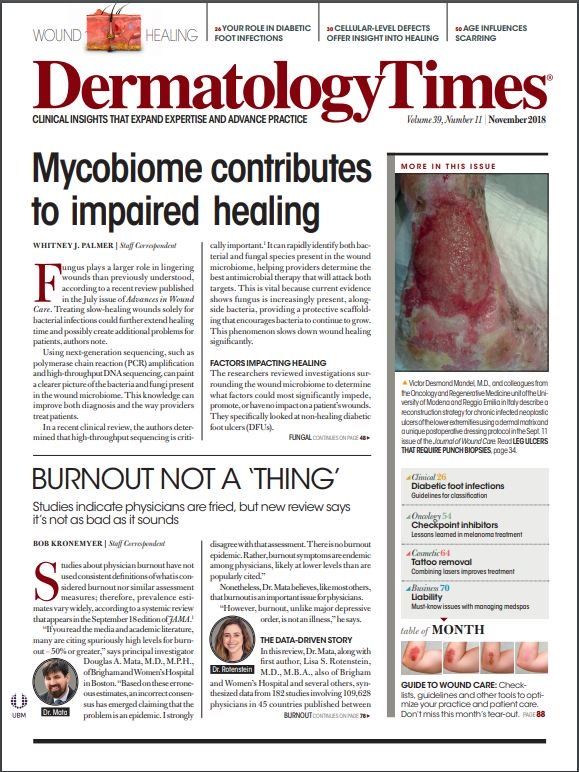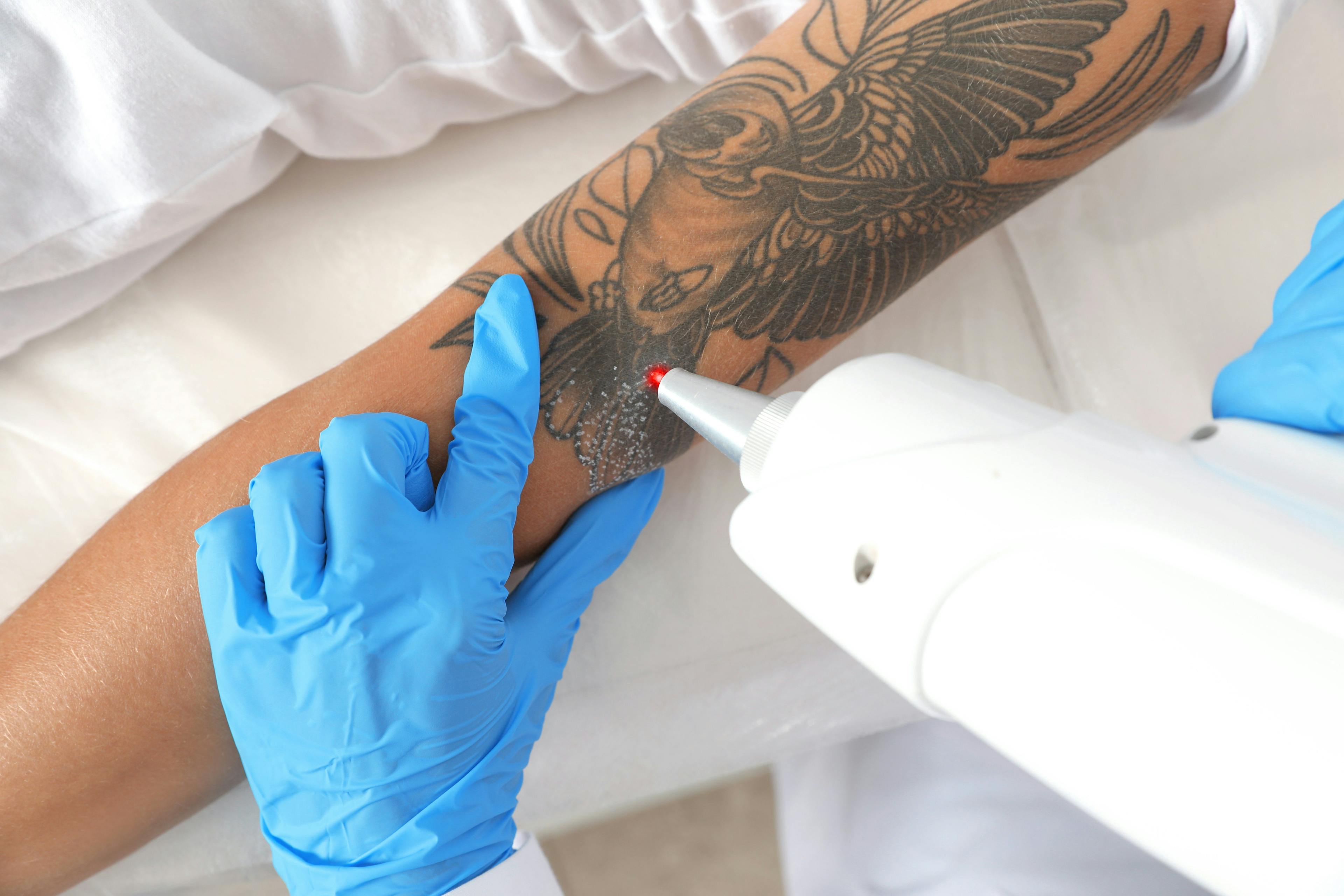- Acne
- Actinic Keratosis
- Aesthetics
- Alopecia
- Atopic Dermatitis
- Buy-and-Bill
- COVID-19
- Case-Based Roundtable
- Chronic Hand Eczema
- Chronic Spontaneous Urticaria
- Drug Watch
- Eczema
- General Dermatology
- Hidradenitis Suppurativa
- Melasma
- NP and PA
- Pediatric Dermatology
- Pigmentary Disorders
- Practice Management
- Precision Medicine and Biologics
- Prurigo Nodularis
- Psoriasis
- Psoriatic Arthritis
- Rare Disease
- Rosacea
- Skin Cancer
- Vitiligo
- Wound Care
Publication
Article
Dermatology Times
Combination therapies may be best for tattoo removal
Author(s):
EADV report summarizes the latest advances in laser technology for tattoo removal.
PARISâWhile nano-second Q-switched lasers (ns-lasers) are still considered the gold standard for tattoo clearance, newer methods such as picosecond lasers (ps-lasers) and combination therapies might hold more promise in effectively removing tattoos, particularly in more complicated indications, researchers reported at the European Academy of Dermatology and Venereology (EADV) Congress on Sunday (Sept. 16, 2018).
Agneta Troilius Rubin, M.D., of Skane University Hospital in Sweden, reviewed advances in vascular and pigmented lasers at the meeting.
The last few decades have seen significant advances in dermatologic laser surgery, she said. These developments have revolutionized the treatment of skin alterations and have brought with them greater precision and efficacy. In parallel to these technological advances, the increase in tattoos being acquired means there is a greater demand for their removal.
After recognition of the clinical application of ns-lasers in the early 1990s, their use in tattoo removal became increasingly common. While effective, certain colors may be resistant to ns-lasers, pigmentary changes and blistering can occur, and the need for multiple treatments results in long treatment durations with significant intervals between laser sessions.
PICOSECOND LASERS
The clinical efficacy of ps-lasers was first reported in the late 1990s, with a more efficient and faster removal of pigmented lesions than ns-lasers. Despite this, the first commercially available ps-laser for tattoo removal and treatment of pigmented lesions (the 755-nm alexandrite laser, PicoSure) was approved by the FDA in 2012. In a separate talk, Klaus Fritz, M.D., said that the shorter pulse duration of just 1012 seconds makes this a revolutionary laser technology in tattoo removal.
“The picosecond laser has been reported to achieve removal in fewer sessions than the nanosecond laser, and with less in the way of unwanted side effects,” said Troilius Rubin, M.D.
The ps-laser also limits damage precisely to the pigment target, which gives a greater efficacy. It is a good option for tattoos that are not responsive to ns-lasers, as well as for multicolored tattoos3. That said, true color blind lasers have not yet been achieved. The ps-laser also causes less induction of post-inflammatory hyperpigmentation in susceptible skin types, such as Asian skin. It also works well for dermal melanocytosis, but is less effective for melasma.
CO2 LASER TREATMENT
The removal of cosmetic tattoos is complicated not only by their aesthetically sensitive location, but also in that they often contain white metallic compounds that darken on pigment-specific laser treatment. Ablative CO2 laser treatment can be effective in these cases, because it does not target specific tattoo inks and thus causes no paradoxical tattoo ink darkening. One review, published in June, reported that CO2 laser treatment of cosmetic tattoos carries no risk of paradoxical pigmentation and CO2 laser vaporization significantly improved removal of eyeliner and lip liner tattoos4. There were no reports of infection or scarring, and side effects included erythema, edema, and serosanguinous drainage.
MULTIPLE-PASS METHODS
A major limiting factor of ns-laser treatment is the development of cavitation bubbles and vacuoles within the epidermis and dermis that result from the rapid heating of tattoo ink particles. Q-switched lasers also have no effect on deep-intradermal pigment. Enhanced tattoo removal through epidermal clearance can be achieved through multiple-pass methods using the R20 protocol with the perfluorodecalin (PFD) patch, which helps reduce laser frosting caused by laser-induced microbubbles. The PFD patch has been available on the market since 2015. While the R20 method has the obvious advantage of faster results, it has been associated with more pronounced skin injury, cannot be used at 532 nm for removal of warm-colored tattoos because of side effects, and is less suitable for patients with darker skin tones due to the more aggressive method.
COMBINATION TREATMENT
Because ps-lasers can be expensive, another option is to use combined wavelengths. “Use what you have and use your knowledge to find appropriate combinations,” Dr. Rubin said. While there are too few cases to make any solid conclusions, Dr. Rubin described preliminary results from five patients, which revealed slightly better clearing with the 1,550-nm Nonablative Fractional Laser (NAFL 1550)+YAG than the other combinations tested (YAG+YAG and fractional CO2+YAG) after three treatments and at the four-month follow-up. Good results and a short recovery were also achieved with YAG+YAG and CO2+YAG, but these combinations were associated with more side effects, including hypopigmentation, skin texture changes and worse pain.
“Another interesting method is to accelerate tattoo removal with acoustic shockwaves in conjunction with a picosecond laser,” Dr. Rubin said. A recent case study, published earlier this year, reported an 80% tattoo clearance with ps-laser with acoustic shockwave therapy compared to 60% clearance with ps-laser treatment alone5. A PFD patch was also used in both treatments. “They found that this acoustic shock increased lymphatic drainage and metabolic activity, thereby accelerating the clearance of the dermal pigment vacuoles.” The portion of the tattoo that received the acoustic shockwave therapy also presented with less edema, erythema, and epidermal crusting.
Another rapid and effective method for blue/black tattoo removal has been revealed in a split-lesion trial6. Combined CO2 and QS Nd:YAG (1064 nm) laser treatment resulted in a statistically significant improvement on the combination side (vs. the Q-switched laser treatment alone side) in Indian skin. More research on the efficacy of combined therapies are warranted, especially considering the greater patient demands for tattoo clearance.
REFERENCES
1. Troilius Rubin, S. (2018). Advances in vascular and pigmented lasers, The 27th European Academy of Dermatology and Venereology Congress, Paris, France, 16th September, 10:35 - 10:55
2. Fritz, K. (2018). Tattoo removal, The 27th European Academy of Dermatology and Venereology Congress, Paris, France, 12th September, 09:32 - 09:48.
Affiliation: Dermatology and Laser Center, Landau - Germany
3. Kasai, K. (2017). Picosecond Laser Treatment for Tattoos and Benign Cutaneous Pigmented Lesions (Secondary publication). Laser therapy, 26(4), pp.274-281.
4. McIlwee, B.E. and Alster, T.S. (2018). Treatment of Cosmetic Tattoos: A Review and Case Analysis. Dermatologic surgery: official publication for American Society for Dermatologic Surgery [et al.].
5. Vangipuram, R., Hamill, S.S. and Friedman, P.M. (2018). Accelerated tattoo removal with acoustic shock wave therapy in conjunction with a picosecond laser. Lasers in surgery and medicine. 2018 Jun 25.
6. Sardana, K., Garg, V.K., Bansal, S. and Goel, K. (2013). A promising splitâlesion technique for rapid tattoo removal using a novel sequential approach of a single sitting of pulsed CO2 followed by Qâswitched Nd: YAG laser (1064 nm). Journal of Cosmetic Dermatology, 12(4), pp.296-305.

Newsletter
Like what you’re reading? Subscribe to Dermatology Times for weekly updates on therapies, innovations, and real-world practice tips.



























